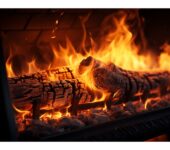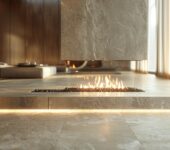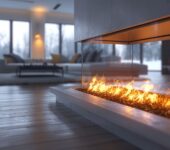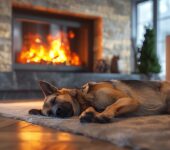Table of Contents
America is burning up. More than 350,000 fires broke out in American homes in 2019. Many of these fires could have been prevented.
National Fire Prevention Week takes place between October 9 and October 15. It is a perfect opportunity to familiarize yourself with ways you can start preventing fires. One area you can focus on is your fireplace.
How should you prepare for fires that start in your fireplace? How should you clean your fireplace and chimney? What tools should you use to start and put out fires?
Answer these questions and you can celebrate Fire Prevention Week in 2022 the right way. Here are seven effective fireplace safety tips.
1. Practice Fire Drills
The most important thing you can do in fire prevention is practice fire drills. You should have a drill at least once a season, if not more often.
Practice what you would do if a fire started in your fireplace. You should rehearse putting out a fire, evacuating the house, and treating injuries.
After the drill, assess what you and your family can do better and write a home fire escape plan. You may need to remove objects off the floor so you can get out of the house sooner. You should also think about placing a first-aid kit near your fireplace, making it easier for you to treat burns.
2. Install Smoke and Carbon Monoxide Detectors
You should put at least one smoke and carbon monoxide detector near your fireplace. You should also place additional detectors in the major rooms of your house, including one in each bedroom. Take a look at a gallery of fireplaces so you know where exactly to put your smoke detectors.
Check the batteries in your detectors so you know they are working properly. Draw yourself a map or take photographs so you know where the detectors are.
3. Put Out All Fires in Your Fireplace
You should never leave a fire in your fireplace unattended. Logs can roll out of your fireplace, or sparks can fly out and start fires elsewhere.
If you need to step away, you should put the fire out. Use your poker to separate the fuel from the burning embers. Use your shovel and baking soda to bury the fuel and embers until the flames die out.
Do a visual inspection to make sure there are no embers left. If you notice glowing or smoking embers, you can crush them with your poker. Do not put them out with your fingertips, as they can be very hot.
4. Clean Your Fireplace
Ash leftover from previous fires can create excessive smoke, which can result in smoke inhalation. If you have an inch or more of ash in your fireplace, you need to clean your fireplace out.
Remove any logs or stones you may have. Use a vacuum cleaner to remove the dust and debris you notice, including underneath your gas grate.
If the walls and floor of your fireplace have grime on them, you can clean them with a brush dipped in a cleaning solution. You should then wipe the surfaces of your fireplace with a dry cloth before letting them air dry.
5. Check Your Chimney
You should inspect your chimney before you light a fire. If it is clogged, you need to clear the chimney out before you light a fire.
Go up on your roof and inspect your flue liner and chimney cap. If you see debris, you can use a brush to push or scrub it off.
If other parts of your chimney are clogged, you may want to hire a chimney cleaning service. Grime and debris can fall into your house, and you may accidentally break parts of your chimney while cleaning. Wait until after National Fire Prevention Week, as many people hire chimney cleaning companies during the week.
6. Stay Away From Your Fireplace
You should install a cover over your fireplace so sparks and logs cannot fall out. You can buy many different covers, including ones made of plexiglass, mesh, and iron. Whatever cover you buy should fit completely over the front of your fireplace and be easy to clean.
You, your child, or your pet can burn themselves if you have a glass front on your fireplace. You should install a safety screen around the glass front to make the glass cover harder to touch.
Do not cook food in your fireplace or stick objects in the flames. If you need to add wood to your fire, you can use your tongs and poker to place it inside safely.
7. Use the Right Wood
You should only ever put local firewood in your fireplace. Some firewood contains pests, which can spread through your house and infect local trees.
In general, hardwoods like oak burn long and at moderately high heats. Softwoods like pine can produce higher temperatures, but they burn very quickly. If you want to light a quick fire, you should use softwoods, but make sure the materials in your fireplace can handle high heat.
You should store your wood in an environment where it will be dry. Dry wood creates less smoke and burns evenly. You can keep it outside, but you should put it on tables or shelves so pests cannot get inside.
Celebrate National Fire Prevention Week
Take advantage of National Fire Prevention Week. Organize a fire drill on October 9 and talk to your family about how you can stay safe. Install smoke detectors and use your poker to put your fires out.
Clean your fireplace and chimney regularly. While a fire is burning, you should use a cover to prevent sparks from flying out. Keep your firewood dry and free of pests, and only use as much wood as you need.
If you have questions about safety, talk to experts in your area. Dreifuss Fireplaces serves Philadelphia residents. Contact us today.
Latest Articles

Is It Normal For Sparks To Come Out Of Chimney?
Table of Contents1 What Are Sparks in a Chimney?2 What Are the Dangers of Sparks in a Chimney?3 How to Prevent Sparks from Coming Out

How Garage Doors Work
Table of Contents1 Types of Garage Doors2 Components of a Garage Door3 How a Garage Door Works4 Safety Features of Garage Doors5 Maintenance and Troubleshooting

What Kind Of Paint To Use On Metal Garage Doors
Table of Contents1 Why Paint Your Metal Garage Doors?2 Types of Paint for Metal Garage Doors3 Factors to Consider When Choosing Paint for Metal Garage




















































































